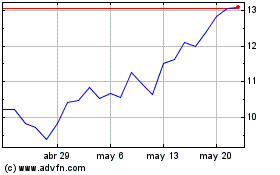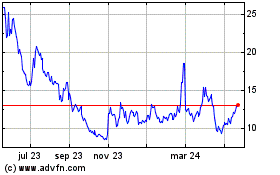- First in vivo gene insertion clinical trial dosing infants
reports complete clinical response in the first participant at the
lowest dose level (1.3 x 1013 GC/kg) of ECUR-506 from three months
post exposure to the end of study (six months post exposure) as
demonstrated by the removal of standard of care ammonia scavenging
medicines, followed by absence of hyperammonemic crises and
normalization of protein intake
- The OTC-HOPE Phase 1/2 trial has regulatory authorization in
four geographies (US, UK, Spain and Australia) and is currently
enrolling with the complete data readout anticipated in 1H
2026
- ECUR-506 for neonatal onset OTC deficiency represents a
meaningful potential clinical and commercial opportunity, affecting
over 1,000 births per year globally
iECURE, Inc., a gene editing company focused on
the development of mutation-agnostic in vivo gene insertion
therapies for the treatment of liver disorders with significant
unmet need, today reported preliminary findings from the first
infant dosed in the ongoing OTC-HOPE Phase 1/2 study of ECUR-506,
the company’s clinical candidate designed to treat neonatal onset
ornithine transcarbamylase (OTC) deficiency. Treatment with
ECUR-506 was generally well tolerated in this infant with no
significant clinical safety concerns apart from asymptomatic
transaminitis at four weeks. The asymptomatic transaminitis was
managed with immunosuppressive therapy and resolved within four
weeks. Twelve weeks after a single dose of ECUR-506, ammonia
scavenger medication was discontinued and mean daily protein intake
was increased to age-appropriate levels. Protein liberalization was
well tolerated, and the subsequent mean ammonia level remained
within normal limits and was reduced compared to the mean
pretreatment level.
iECURE’s approach to gene editing for its initial programs,
including OTC deficiency, relies on the delivery of two
adeno-associated virus (AAV) vectors comprised of the same capsid,
but each carrying different payloads. ECUR-506 comprises two
vectors, an ARCUS® nuclease vector targeting gene editing in the
well-characterized PCSK9 gene locus and a donor vector that inserts
the desired functional OTC gene. iECURE has licensed the ARCUS
nuclease for ECUR-506 from Precision BioSciences (Nasdaq: DTIL).1
The cut in the PCSK9 site serves as the insertion site for the OTC
gene, providing a potential path to permanent expression of a
functional gene.
“Our team is highly encouraged to see this baby, who after
having experienced two spikes in blood ammonia levels before three
and a half months of age, reach a point where he no longer needs
ammonia scavengers and is eating age-appropriate levels of protein
for a baby of his age,” said Julien Baruteau, M.D., Ph.D., MRC
Clinical Scientist Fellow and Group Leader at University College
London Great Ormond Street Institute of Child Health and Consultant
in Metabolic Medicine at Great Ormond Street Hospital for Children
in London, and principal investigator in the study. “Standard of
care for babies with neonatal OTC deficiency relies on liver
transplantation in infancy, a procedure with significant risks of
complications. This novel gene therapy approach might enable
bypassing the need for liver transplantation. While this is very
early data, I am hopeful that this baby will continue along this
encouraging trajectory and that other babies who enroll in this
study will have similar experiences. This novel gene therapy
technology may herald new avenues to treat babies with severe liver
genetic diseases.”
OTC deficiency is a serious rare genetic disease wherein
ammonia, a waste product that is generated when the body breaks
down proteins, builds up in the blood (hyperammonemia). Ammonia is
toxic to the brain when it accumulates at high levels. Newborns
with neonatal onset OTC deficiency experience symptoms of
hyperammonemia shortly after birth, including lethargy, poor suck
and vomiting, that if left untreated can quickly escalate to
seizures, brain damage, coma and eventual death.
Rescuing newborns from their first hyperammonemic crisis (HAC)
often requires dialysis and intravenously delivered ammonia
scavenger medicines. Once the infant is stabilized, ongoing medical
management, including ammonia scavenger dosing and use of a
protein-restricted diet, is conducted to protect the brain against
further ammonia buildup. Despite medical management, additional
HACs can occur leading clinicians to recommend a liver
transplantation in the first year of life. While curative, liver
transplantation includes risks such as graft failure and an
increased risk of malignancy and infection due to prolonged use of
immunosuppressive drugs.
“To our knowledge, this is the very first infant to have ever
received an in vivo, liver-directed, gene insertion investigational
product. While still early days and follow up is limited to the
first six months post exposure, the elimination of this baby’s need
for the current standard of care observed after a few months of
receiving ECUR-506 may represent a historic milestone for children
with neonatal OTC deficiency, their families and their care teams.
In vivo gene insertion may foretell the future treatment approach
for a host of severe, early-onset, genetic conditions and may mark
the beginning of a new chapter in the evolution of gene therapy,”
said Gabriel Cohn, M.D., MBA, Chief Medical Officer of iECURE. “It
is important to note that elevations in liver enzymes, particularly
ALT, are not uncommon in AAV-mediated gene therapy trials. We have
updated the clinical trial protocol to more promptly detect and
more aggressively manage this type of event, if needed, in future
clinical trial participants.”
Summary of Findings in the First Participant:
- The first infant dosed with ECUR-506 was initially diagnosed
with neonatal onset OTC deficiency following a HAC during the first
week of life, and he was stabilized with hemodialysis and managed
with standard of care ammonia scavenger medication and protein
restriction. Molecular genetic testing confirmed the
diagnosis.
- At 3.5 months of age, while on a protein restricted diet and on
scavenger medicine, the participant experienced a breakthrough
HAC.
- At 6.5 months of age, the participant received a single
infusion of the lowest dose (1.3 x 1013 GC/kg) of ECUR-506, which
was generally well tolerated.
- Asymptomatic transaminitis was noted during routine lab testing
at four weeks post-ECUR-506 exposure. A liver biopsy was
subsequently performed at six-weeks post dosing which confirmed an
acute T-cell inflammatory response. By eight weeks post-ECUR 506
exposure, following immunosuppressive therapy management, the grade
3 transaminitis resolved.
- On the basis of reduced serum glutamine levels, ammonia
scavenger medication weaning was initiated with complete
discontinuation achieved at 12 weeks post-ECUR-506 dosing.
- Protein allowance was subsequently increased to the
age-appropriate level for infants without OTC deficiency.
- The participant’s mean ammonia and serum glutamine levels have
remained within normal limits, and the participant has not
experienced any HAC as of 6 months post treatment.
- The participant transitioned to the long term follow up study
(ECUR-LTFU) for further monitoring.
- Dosing of cohort 1 (Low Dose) continues and the complete
six-month data readout for all patients is anticipated in the first
half of 2026.
- Full study data of the first participant will be presented at
the 2025 American College of Medical Genetics and Genomics (ACMG)
Annual Clinical Genetics Meeting in Los Angeles, California on
March 18-22, 2025.
“The current standard of care for infants affected by neonatal
onset OTC deficiency leaves significant room for improvement, and
should these results hold true for additional participants, we
believe there is tremendous potential for our gene editing approach
to treat this devastating disease,” said Joe Truitt, Chief
Executive Officer of iECURE. “These initial findings are
encouraging, and in 2025 we look forward to engaging with
regulatory agencies on potential accelerated approval pathways,
expand the trial locations across the globe and complete the
enrollment of the OTC-HOPE trial."
In addition to reporting these data from the first participant,
iECURE also announced updates around clinical trial locations. UCLA
Mattel Children's Hospital and Children’s Hospital of Colorado are
the first two clinical trial sites in the United States open for
enrollment. Also, iECURE has secured Clinical Trial Authorization
from the European Union (EU) and the European Economic Area (EEA)
under the EU Clinical Trial Regulation by the Spanish Agency of
Medicines and Medical Devices (AEMPS) and will be working to open
additional sites in Spain.
About the OTC-HOPE Study
The OTC-HOPE study is a Phase 1/2 first-in-human clinical trial
of ECUR-506 in baby boys with genetically confirmed neonatal onset
OTC deficiency and has been cleared to evaluate ascending dose
levels of ECUR-506, if necessary. The study is enrolling newborn
males up to seven months of age at screening who are diagnosed with
severe neonatal onset OTC deficiency and meet certain other
criteria. The primary objective is to assess the safety and
tolerability of intravenous administration of a single dose of
ECUR-506. It will also assess the pharmacokinetics and efficacy of
ECUR-506 administration and the potential effects of ECUR-506 on
disease-specific biologic markers, developmental milestones and
quality of life. The main study will occur in a series of stages
over a 10-month period, including screening, stabilization, dosing
eligibility, study drug administration, and six-month follow-up.
Upon completion of the OTC-HOPE study, participants transition to
the 14.5 year long term follow up study (ECUR-LTFU). For more
information, visit https://OTC-HOPE.com.
About iECURE
iECURE is a clinical-stage gene editing company focused on
developing therapies that utilize mutation-agnostic in vivo gene
insertion for the treatment of liver disorders with significant
unmet need. We believe our approach has the potential to restore
the function of a dysfunctional gene, regardless of mutation, by
knocking-in a functional copy of that gene to offer durable gene
expression and long-term, potentially curative, therapeutic
benefit. Our management team has extensive experience in executing
global orphan drug and gene therapy clinical trials and
successfully commercializing multiple products. We intend to
leverage our team’s core strength in research and development
strategy to identify what we believe to be the most suitable target
and modality for our product candidates to address particular liver
diseases. For more information, visit https://iecure.com and
follow on LinkedIn.
About Precision BioSciences & ARCUS®
Precision BioSciences, Inc. is a clinical stage gene editing
company dedicated to improving life (Nasdaq: DTIL) with its novel
and proprietary ARCUS® genome editing platform that is designed to
differ from other technologies in the way it cuts, its smaller
size, and its simpler structure. Key capabilities and
differentiating characteristics may enable ARCUS nucleases to drive
more intended, defined therapeutic outcomes. Using ARCUS,
Precision’s pipeline is comprised of in vivo gene editing
candidates designed to deliver lasting cures for the broadest range
of genetic and infectious diseases such as chronic hepatitis B
where no adequate treatments exist. For more information about
Precision BioSciences, visit
www.precisionbiosciences.com.
[1] iECURE has licensed the ARCUS® nuclease from Precision
BioSciences for four gene insertion programs including OTC, CTLN1
and PKU.
View source
version on businesswire.com: https://www.businesswire.com/news/home/20250109643728/en/
Investors: David Garrett dgarrett@iecure.com
Media: Janine Bogris Inizio Evoke Comms
janine.bogris@inizioevoke.com
Precision BioSciences (NASDAQ:DTIL)
Gráfica de Acción Histórica
De Dic 2024 a Ene 2025

Precision BioSciences (NASDAQ:DTIL)
Gráfica de Acción Histórica
De Ene 2024 a Ene 2025
